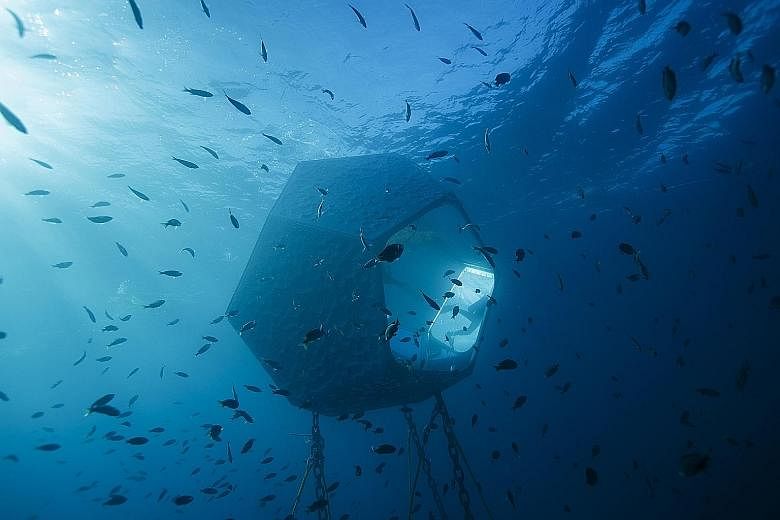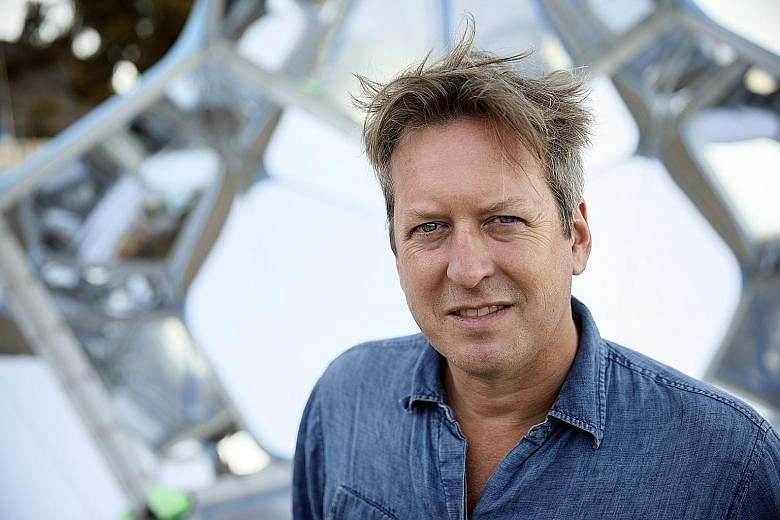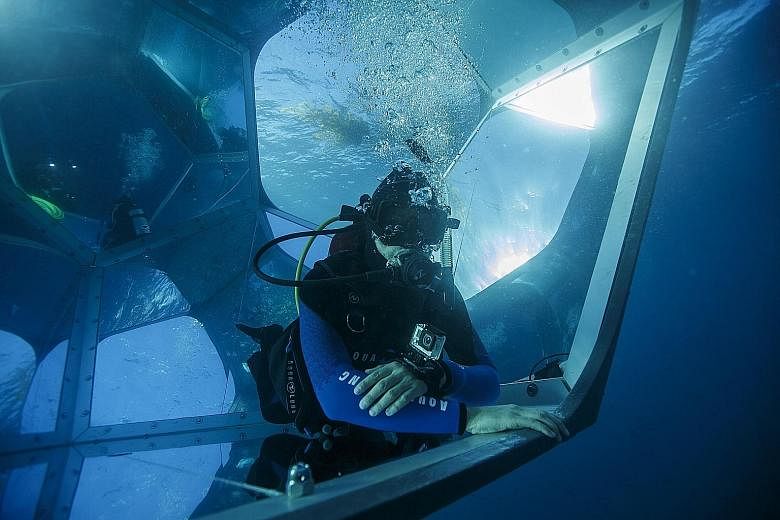OFF CATALINA ISLAND (California) • After a year in development and a month of delays, the first of three underwater swim-in, swim-out pavilions by artist Doug Aitken was submerged in a dive park off Avalon, California, and moored to the ocean floor.
The 12-sided structure, lined with mirrors to capture sunlight, glowed with an otherworldly beauty at a depth of 4.5m.
Aitken, a California native, was on his first dive to his destination artwork recently, outside the grand Catalina Casino in the Pacific Ocean. The project's producer, Mr Cyrill Gutsch, and two diving instructors tagged along.
Back on land, sounding exhilarated as he recalled the play of the reflections off the mirrors, Aitken, 48, said: "It was just hypnotic, with this pulsing light - I could see the ocean floor above me and the sun below me."
The internationally celebrated video artist has long sought collaborations with other artists, musicians and actors to help bring his work to life.
In 2013, he turned a cross-country train ride from Brooklyn to Oakland, California - with recording and art studios on board - into what he called "a nomadic happening", inviting singer-songwriter Patti Smith, restaurateur Alice Waters and artist James Turrell, Danish-Icelandic artist Olafur Eliasson and Switzerland-born artist Urs Fischer to participate.
But making an artwork designed to be experienced at depths of 3 to 12m proved more challenging.
Aitken depended heavily on Mr Gutsch's non-profit environmental group Parley For The Oceans, which is financing the project through private sources, and a team of outside marine experts for engineering.
He also worked with local groups to install the three pavilions at different depths.
And now the structures are subject to the elements, dramatically changing in appearance with the shifting tides, waning daylight, churning water and movement of divers, not to mention the instincts of fish - which were later spotted inside the pavilions, along with a sea lion mesmerised by its reflection.
"The moment the first pavilion entered the water, it stopped being a sculpture for me," Aitken said. "It became this living system - constantly in flux, constantly changing, whether it's the sea life entering it, the kelp pushing at it or swimmers interacting with it."
He described his work as a "lens" or "door" into the ocean terrain. And that is a strange realm, where light travels slower, sound travels faster and the feeling of floating underwater can flood one with sensations of deep peace and quiet.
The immersion into nature is a departure for Aitken, who is best known for video art that uses multiple, fragmented or alternative screens to capture today's hyper- accelerated and technology-driven culture.
His breakthrough work was his eight-projection Electric Earth, which won the International Prize at the Venice Biennale in 1999.
He has also realised high-impact projects in more surprising settings, such as his Sleepwalkers video, about the rhythms of city life, which took over the facade of the Museum of Modern Art in 2007, and his 2011 film, Black Mirror, starring Chloe Sevigny and commissioned by collector Dakis Joannou, which debuted on a floating barge off the coast of Greece.
The Catalina project proved daunting logistically because of the ocean setting.
Mr Gutsch brought in renowned oceanographer Sylvia Earle as an early consultant and submarine builder Liz Taylor to oversee engineering.
Marine expert Bill Bushing conducted a video survey of the dive park to locate a site just outside the marine protected area. High-end boat builder Westerly Marine handled most of the fabrication, with Aitken's studio assistants hand- carving the craggy pavilion surfaces that are not mirrored, made of a composite designed to foster marine growth.
Some initiatives by Parley For The Oceans target specific issues, such as plastic pollution, as in a partnership with Adidas that put such waste to use in manufacturing shoes and soccer jerseys. This one, Mr Gutsch said, was meant to be a broader bid for attention.
"Conservation works only if you put beauty first," he said. "Nobody wants horror stories about destruction done to the ocean; first, you have to fall in love with it."
The installation opens on Dec 4 and is expected to remain for a few months. Anyone wishing to enter it needs to be a certified diver or take a same-day course with an instructor, who will accompany the person underwater.
So how then does one extend the reach of such a work?
Aitken's answer is cameras: He planted three close to the ocean floor and one in each of the pavilions. The Parley For The Oceans and Museum Of Contemporary Art websites will carry video feeds from Dec 4.
"I want to know that a student in Tokyo can open a tablet and see a feed from the pavilions live," he said.
NYTIMES



